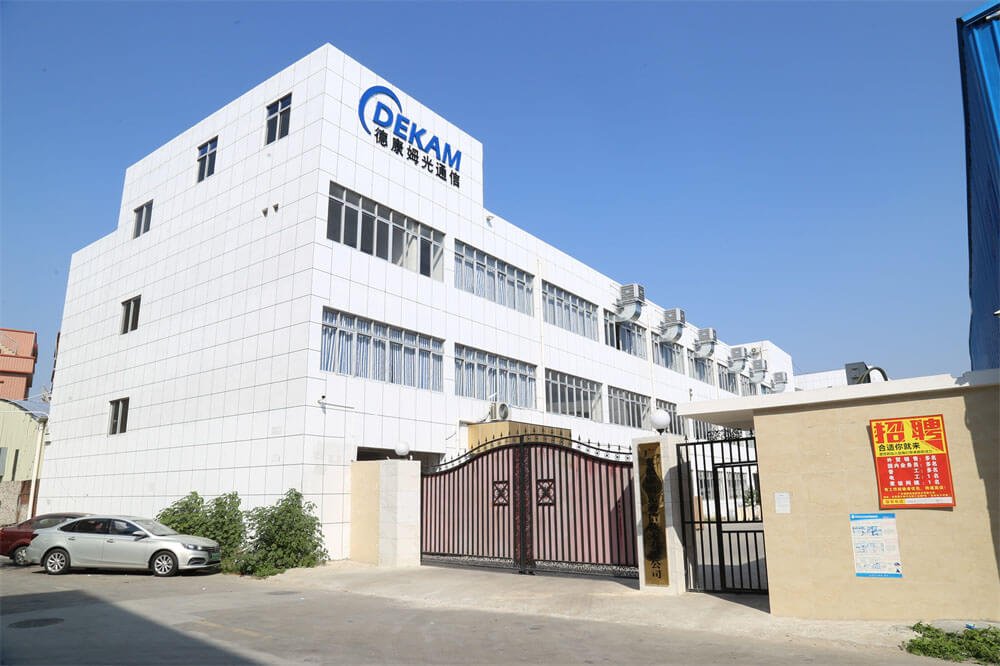Would you like to enhance the speed and reliability of your network? Well! The type of fiber optic cable you choose makes a huge difference. Given the fact that there are many choices, how can you decide which is suitable for you?
In this blog, we shall discuss the various types of fiber optic cables, thus enabling you to make a better decision for your home or business network. So let’s begin!
1) Fiber optic cables: Understanding the basics
“Fiber optic cables are modern communication cables for transmitting data through light signals instead of electricity.”
These consist of hair-like small strands of glass or plastic known as optical fibers that guide light and make sure the loss is minimum over long distances. They are characterized by their high-speed capability, large bandwidth and durability, hence they can be used in the current communication networks.
Key Components of Fiber Optic Cables
- Core: The core is located at the centre of a fiber where it carries light to travel. It is made from either plastic or glass.
- Cladding: It surrounds the core reflecting back into it so as to prevent any loss of signal strength by keeping it strong.
- Protective coating: This outer layer insulates fragile fibers against physical damage, moisture and dirt. Thus ensuring the effective functioning of the cable later on.
Let’s have a quick look at how these fiber cables work;
First of all, the data, texts, videos and emails are converted into light beams which are then sent through the fiber optic cable. The light moves through the core, bouncing off the cladding to retain signal strength and is later changed back to its initial form at the end of this wire.
2) Explain the different types of fiber optic cables
Fiber optics has a number of different types that are specially designed for particular uses and settings. Here they are in plain words to help you easily see what you require.
01. Mode of Transmission
Single-Mode Fiber (SMF)
A single-mode fiber has a tiny core, just about 9 micrometers in diameter where it allows one light signal to travel through, making it the best option for long travels. For example, ADSS (All-Dielectric Self-Supporting) fiber optic cable is single-mode fiber which can be for aerial installations over long distances without using extra metal support structures.
Features:
- Signal loss is very low typically not above 0.2 dB/km.
- Transmission requires a laser light source.
- Ideal for high-speed data transfer, up to 100 Gbps.
Ideal for:
- Single-mode is commonly used in telecommunications (city-to-city connections), undersea cables, and long-haul internet links where less loss of signal is necessary over distances exceeding 50 km.
Multi-Mode fiber (MMF)
The multi-mode fiber has a relatively big core – normally between 50–62.5 microns which can let many light signals pass at once.
Features:
- Allows multiple signals to travel through the cable at once.
- Signal loss is higher than single-mode, typically around 3.5 dB/km.
- Uses LED light sources.
Ideal for:
- Ideal for short-distance communication, used in data centres, LANs, and office buildings, with cable lengths typically under 2 km.
02. Based on Outer Protection
Armoured Fiber Optic Cables
Armored fiber optic cables or underground fiber optic cables are provided with an added protection layer of steel or aluminium. This layer protects the cable from damages caused by crushing, impacts and animals too.
Ideal for:
- Underground, underwater installations may be exposed to brutal harsh weather conditions or high-risk environments often at depths of up to 300 meters.
Non-armored Fiber Optic Cables
These cables do not have any protective armor so they are lighter and flexible.
Features:
- More economical.
- Appropriate for less risky environmental situations.
Ideal for:
- In cases where significant signal loss does not occur over distances of up to 500 meters, these cables will be the best option for controlled environment installations such as offices, homes and data centres.
03. Based on the installation environment
Indoor fiber Optic Cables
These cables must be used inside buildings. They have tight buffer coatings which protect against dust, moisture and other atmospheric influences like humidity caused by temperature changes or condensation.
Features:
- Flexible plus easy installation process.
- Designed for low-risk external danger areas.
Ideal for:
- In offices, homes, data centres and through walls, ceilings or floors, often over distances of up to 300 meters.
Outdoor fiber Optic Cables
Designed for harsh outdoor conditions, these cables are impervious to moisture, ultraviolet rays and extreme temperature variations. For instance, you can go for GYFTY which is a type of outdoor fiber optic cable, featuring loose tube construction for strength and protection in harsh environments.
Features:
- Resistant to environmental factors such as dampness and sunlight.
- For extra protection can contain gel or steel layers.
Ideal for:
- Used in broadband connections, rural internet networks or aerial installations where they can be stretched over a distance of up to 20 km.
04. Based on the Type of Media
Glass fiber Optic Cables
These cables are made from high-quality glass which allows signals to travel longer distances without loss of quality.
Features:
- Low signal loss is typically around 0.2dB/km.
- It can transmit data at speeds up to 100Gbps.
Ideal for:
- Useful in telecom networks, high-speed internet connections and submarine cables that cover a distance over 50 kilometers away.
Plastic Optical fiber (POF)
The material used is plastic instead of glass. These are flexible making them affordable and suitable for short communication ranges.
Features:
- Flexibility and ease of installation are their characteristics.
- Although more costly than glass fibers it has a higher signal loss (approximately 2dB/Km).
Ideal for:
- Most suitable for home networks, automobile systems, or other small installations having cable lengths commonly less than 100 m.
05. Based on the applications
Specialty fiber Optic Cables
These are designed to meet the needs of specific applications such as scientific research, military communication and medical imaging.
Features:
- Designed for tasks that require precise transmission of light signals.
- They are normally more costly due to their specialized capabilities.
Ideal for:
- Depends on highly sensitive sectors like medical imaging or military communication with varying custom lengths based on the need.
Aerial fiber optic cable
Aerial fiber optic cables are supposed to be above but not inside the earth- they are usually located on poles or some other structures. For instance, you can go for GYTA & GYTA53 Fiber Optic Cable, GYFTY fiber optic cable and ASU fiber optic cables.
Features:
- They are lightweight, thus easier for installation and maintenance.
- The structural design of these cables makes them resistant to such environmental conditions.
- They are strong and thus withstand physical strain or impacts from the environment.
- Unlike underground optic fiber cables, aerial ones tend to be more affordable hence quicker to set up.
Ideal for:
- Mostly in urban and rural areas, these cables are used to connect homes and businesses for broadband internet connections where trenches can not be dug due to impracticability as well as cost.
06. Based on Cable Design
Simplex Fiber Cable
A Simplex cable contains one fiber strand meaning that data can only travel in one direction.
Features:
- One-way data transfer facility.
- Lightweight and easy to handle during installation processes.
Ideal for:
- Applied in TV broadcasting, alarm systems or point-to-point communications where data moves in a single direction such as signal transmission to antennas.
Duplex Fiber Cable
This Duplex cable involves two fibers’ strands hence allowing simultaneous two-way traffic flow of information between the two points.
Features:
- Offers bidirectional data transmission capability.
- Fast and continuous two-way communication is possible through this system design.
Ideal for:
- Widely used in internet networks, telecommunication systems and LANs enhancing seamless interactions among devices or between devices and facilitating smooth uploading and downloading activities.
3) How to choose the right fiber optic cable?
When you are setting up a network, choosing the right fiber optic cable is very important in order to ensure smooth and efficient data transfer. Whether you are setting up a home network or managing a business infrastructure, picking the right cable can be the difference between fast, dependable service at an affordable price and slow unreliable connectivity.
Here are some key factors to consider when making your choice.
Distance Consideration: Think about how far you want the signal to travel. If it’s going over long distances then you will need a cable designed for that purpose, whereas for short distances any basic cable would suffice.
Environmental Aspect of Installation: Think about where you will install the cable – if outside (in contact with weather conditions) or buried underground (weatherproof). In case of indoor use only, it might be enough just to get a impler version.
Type of Communication: Consider whether your communication needs require data transmission in one direction only or they should be bidirectional too; this will help you decide on how many fibers should be inside the cable.
Assess Speed and Bandwidth Requirements: Ensure your cable will be able to handle the speed and capacity of data that you need for your network. If you require rapid data transmission involving large files, go for a cable with high bandwidth.
Consider jacket size: When selecting the appropriate fiber-optic cable, take into account the size of its outer covering which helps to protect it from physical damage, moisture, excessive heat and cold as well as UV radiation. For instance, A standard outdoor jacket may be about 0.9 mm-2.0 mm so that it can be sturdy in unforgiving environments. Make sure it is right for your space and provides enough flexibility.
Cost and Budget: Finally, think about how much you are willing to pay. You may have to consider the cost of more durable or higher-performing wires in relation to what your network requires.
4) Final Words
To sum up, taking a suitable fiber optic cable is key to having a successful and efficient network set-up. We have explored various kinds throughout the article which you have to know before making an appropriate choice.
If you are in search of a trustworthy manufacturer then, look no further, as we at Dekam Fiber Company present different types of excellent quality fiber-optic cables for your convenience. So, visit DEKAM today for more information on our product line that can improve your network’s performance.




